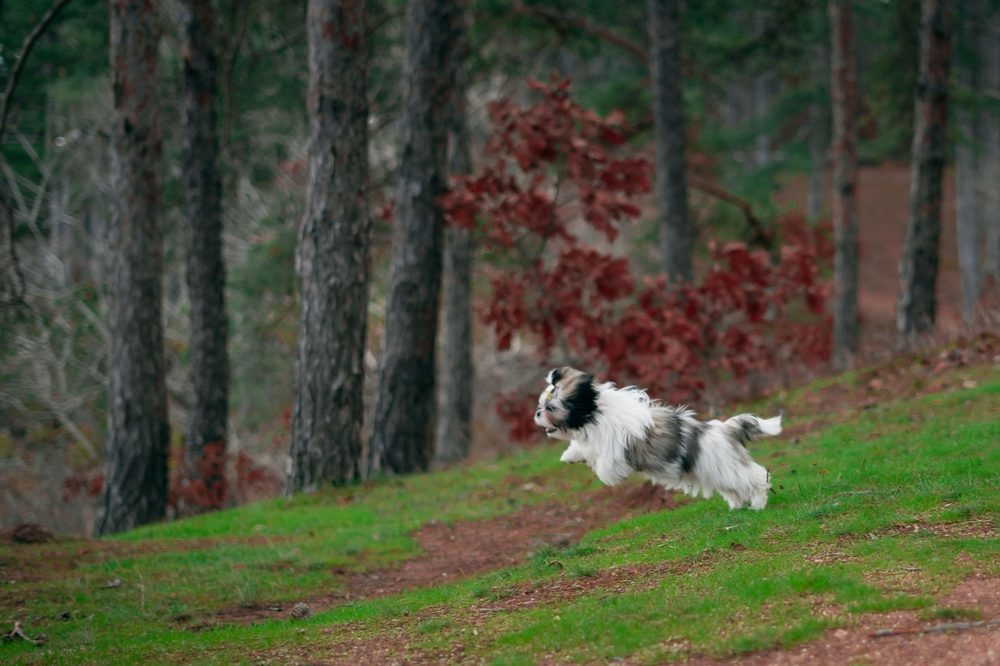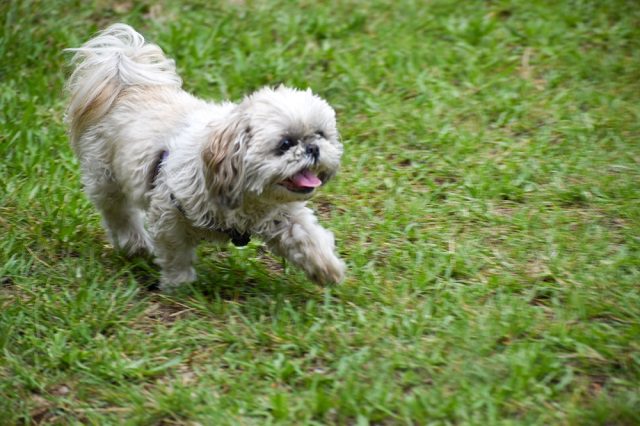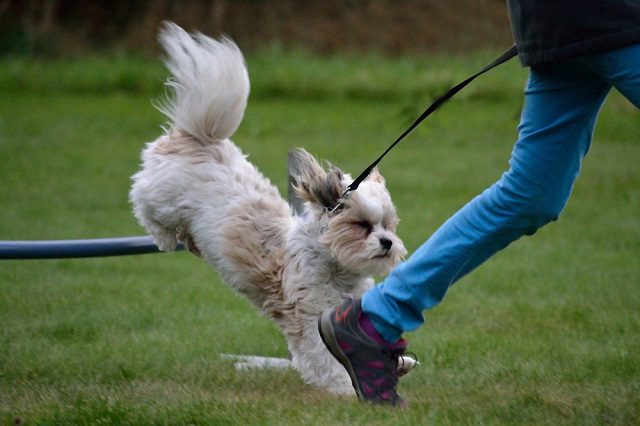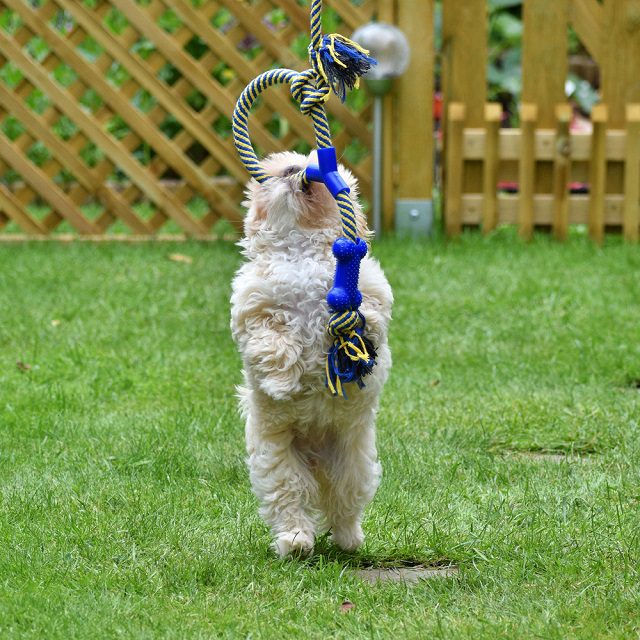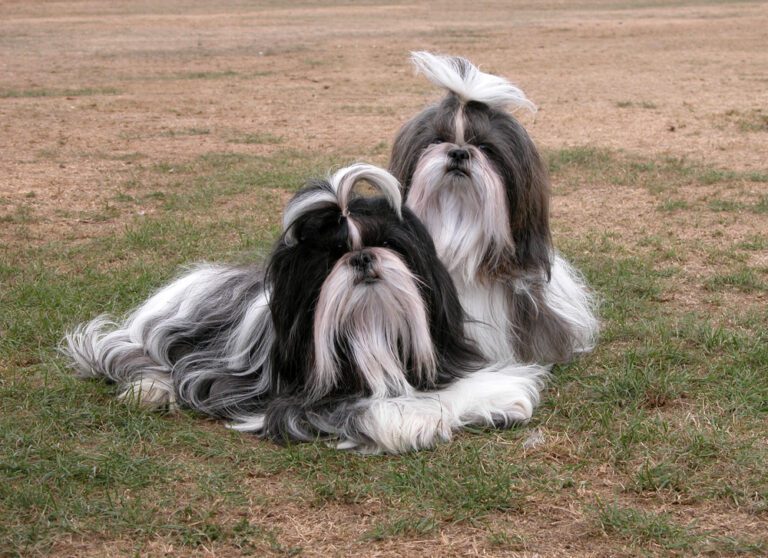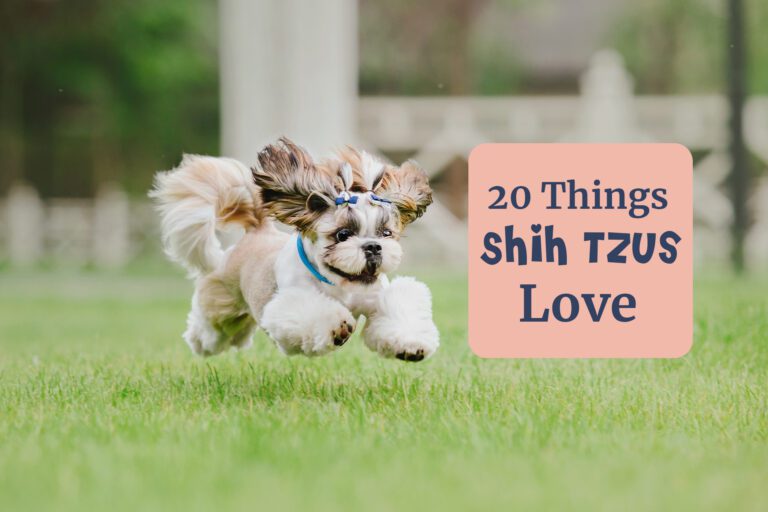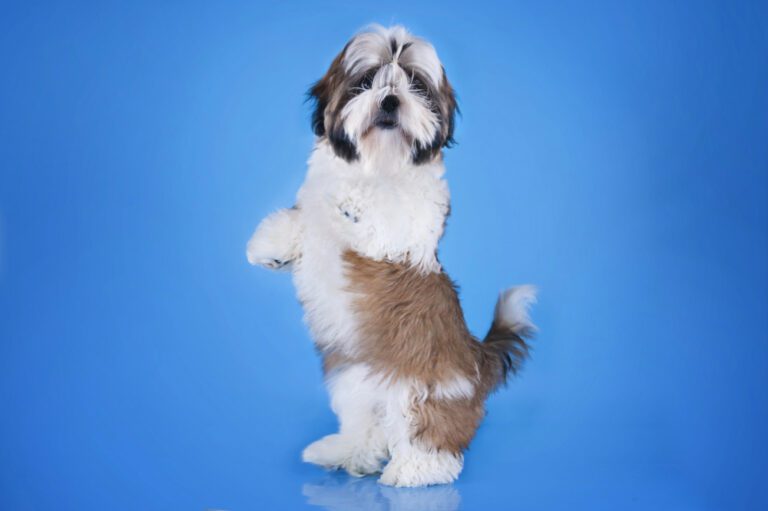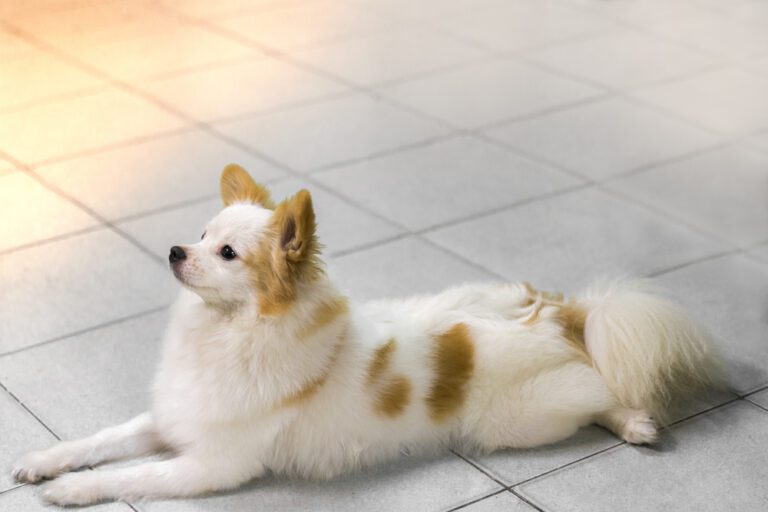The Science Behind Shih Tzu Jumping: A Professional Analysis
Shih Tzu, known for their affectionate demeanor and distinctive appearance, often surprise their owners with their remarkable jumping abilities. This article delves into the science behind Shih Tzu jumping, offering a professional analysis of the factors influencing this behavior.
Shih Tzus, characterized by their sturdy build and lively disposition, possess physical attributes that contribute to their impressive jumping skills. The anatomy of a Shih Tzu, particularly their muscular hind legs and agile bodies, plays a crucial role in their ability to execute jumps with surprising height and precision.
Beyond mere physical attributes, the psychology of Shih Tzus also influences their jumping behavior. Understanding the reasons behind their leaps provides valuable insights for dog owners seeking to comprehend and manage this aspect of their pet’s behavior.
This article will explore various parts of the science behind Shih Tzu jumping, including the breed’s physical characteristics, behavioral tendencies, and potential training methods to address or enhance this unique skill. By understanding why Shih Tzu jumps comprehensively, owners can foster a healthier relationship with their furry companions while ensuring the safety and well-being of both the pet and its environment.
Stay tuned as we unravel the secrets behind Shih Tzu jumping, providing a professional analysis rooted in science and practical insights.
The Anatomy of a Shih Tzu: How Their Physical Characteristics Enable Jumping
To comprehend the science behind Shih Tzu’s impressive jumping prowess, it is imperative to delve into the intricacies of their anatomy. The unique physical characteristics of this breed contribute significantly to their ability to execute remarkable jumps.
Muscular Hind Legs: Powerhouses for Vertical Leaps
At the core of a Shih Tzu’s remarkable jumping ability lies the strength and agility of its muscular hind legs. These limbs are powerhouses, allowing the dog to generate the force necessary for impressive vertical leaps.
Compact and Robust Build: Achieving Balance and Control
The Shih Tzu’s compact and robust build is crucial to their jumping prowess. Evolving as companion dogs for Chinese royalty, their bodies are finely tuned for balance, facilitating control and coordination during jumps.
Size Matters: The Advantage of Being Compact
The relatively small size of Shih Tzus is a distinct advantage in its jumping capabilities. With less body mass to lift, they can achieve greater heights than larger breeds, showcasing a unique interplay between size and agility.
Tailoring Jumps to Environment: Adaptability in Action
Beyond their inherent physical attributes, Shih Tzus display remarkable adaptability in tailoring their jumps to different environments. Their ability to adjust their jumping style based on their surroundings highlights the breed’s cognitive flexibility.
The Role of Skeletal Structure: Foundation for Precision
Examining the skeletal structure of Shih Tzus unveils the foundation for their precise jumps. A closer look at bone density and structure provides insights into how these dogs achieve accuracy in their leaps, landing with finesse.
By dissecting the anatomy of a Shih Tzu, we gain a deeper understanding of the intricate physical attributes that contribute to their remarkable jumping skills. In the subsequent sections, we will delve into the psychological aspects and training methods associated with Shih Tzu jumping, comprehensively exploring this captivating canine behavior.
The Psychology of Jumping: Exploring the Motivations Behind Shih Tzu’s Leap
Understanding the intricate psychology behind a Shih Tzu’s jumping behavior is essential for pet owners seeking insights into their furry companions. This section unravels the motivations that drive Shih Tzus to leap, shedding light on the psychological aspects contributing to this intriguing behavior.
Innate Playfulness: Jumping as a Form of Expression
One of the primary psychological motivations behind Shih Tzu’s leaps is their innate playfulness. These dogs are known for their lively and spirited nature, and jumping becomes a natural form of expression, allowing them to engage with their environment and communicate joy.
Social Interaction: Seeking Attention and Affection
Shih Tzus are social creatures that thrive on human interaction. Jumping can be a means for them to seek attention and affection from their owners. Understanding this aspect of their psychology is crucial for establishing positive and rewarding interactions.
Energy Release: Channeling Exuberance through Jumps
For Shih Tzus, jumping serves as a means of releasing pent-up energy. This is especially true for moments of excitement or anticipation. Recognizing the role of jumping in energy release allows owners to provide appropriate outlets for their dog’s vitality.
Communication and Expression: Non-Verbal Signals
In the canine world, body language is a powerful form of communication. Shih Tzus may employ jumping as a non-verbal signal to convey excitement, happiness, or a desire to play. Deciphering these signals enhances the bond between the pet and the owner.
Training and Positive Reinforcement: Shaping Behavior
The psychology of jumping also involves the potential for activity and behavior shaping. Understanding the motivations behind the jumps enables owners to implement positive reinforcement techniques, redirecting the behavior into more desirable actions.
Exploring the psychology of Shih Tzu jumping provides valuable insights into the motivations guiding this behavior. As we delve further into the science behind these leaps, we will also address effective training methods, fostering a harmonious relationship between Shih Tzus and their owners.
Jumping Techniques: Unraveling the Strategies Employed by Shih Tzus
Examining the jumping techniques of Shih Tzus unveils a fascinating display of agility and strategy. This section delves into the various methods these dogs employ, shedding light on the intricate jumping techniques that contribute to their impressive aerial maneuvers.
The Vertical Lift: Harnessing Hind Leg Power
One prominent jumping technique observed in Shih Tzus is the vertical lift. By harnessing the power of their muscular hind legs, these dogs execute swift and decisive upward movements, achieving impressive heights. Understanding the mechanics of the vertical lift provides insights into the breed’s physical prowess.
Precision Landings: Coordination in Mid-Air
Shih Tzus exhibits remarkable coordination during jumps, leading to precision landings. Their ability to control their bodies mid-air is a testament to their agility. Exploring the factors contributing to these precise landings unveils the breed’s innate sense of spatial awareness.
Adaptability to Terrain: Tailoring Jumps to the Environment
Another notable jumping technique involves the adaptability of Shih Tzus to different terrains. Whether navigating indoors or outdoors, these dogs showcase versatility in tailoring their jumps to suit the environment. Understanding this adaptability adds a layer of complexity to their jumping behavior.
Repetitive Leaps: Expressing Enthusiasm
Shih Tzus often engages in repetitive leaps, expressing their enthusiasm and joy. This jumping technique is a clear manifestation of their playful nature. Exploring the patterns and motivations behind repetitive leaps contributes to a comprehensive understanding of the breed’s behavior.
Variable Jumping Heights: Tailoring Jumps to Purpose
Shih Tzus demonstrates an ability to vary their jumping heights based on purpose. Whether reaching for an object, seeking attention, or expressing excitement, these dogs adjust the intensity of their jumps accordingly. Examining this variability provides insights into their cognitive flexibility.
Unraveling the jumping techniques of Shih Tzus offers a glimpse into the breed’s agility and strategic prowess. As we continue to explore the science behind their jumping behavior, the next section will delve into practical training methods, enabling owners to foster a positive and controlled environment for their energetic companions.
Common Jumping Challenges: Addressing Potential Issues Faced by Shih Tzus
While Shih Tzus are renowned for their impressive jumping abilities, specific challenges may arise in managing this behavior. This section identifies and addresses common jumping challenges faced by Shih Tzus, providing insights for owners seeking to create a safe and harmonious living environment.
Overexcitement and Unwanted Jumps
One prevalent challenge involves Shih Tzus exhibiting overexcitement, leading to unwanted jumps. Understanding the triggers for such behavior and implementing training techniques can help redirect their enthusiasm into more controlled actions.
Jumping on Furniture: Establishing Boundaries
Shih Tzus may develop a habit of jumping on furniture, posing challenges for the dog and its owner. Implementing consistent boundaries and providing alternative outlets for their jumping tendencies can help curb this behavior.
Jumping on Strangers: Socialization Strategies
Shih Tzus, being social dogs, may display jumping behavior when meeting new people. Socialization strategies, including controlled introductions and positive reinforcement, can mitigate the challenges of jumping on strangers.
Potential Injury Risks: Mitigating Health Concerns
Excessive jumping, especially from elevated surfaces, can pose injury risks to Shih Tzus. Owners should be vigilant in identifying potential health concerns, implementing measures to minimize impact, and providing appropriate veterinary care if needed.
Reinforcement of Undesirable Behavior: Breaking the Cycle
Repeated reinforcement of undesirable jumping behavior can create challenges in breaking the cycle. Consistent training methods, positive reinforcement for alternative behaviors, and patience are essential in reshaping their habits.
By acknowledging and addressing these common jumping challenges, Shih Tzu owners can cultivate a positive and controlled environment for their energetic companions. In the following section, we will explore practical training techniques to guide Shih Tzus toward more desirable jumping behaviors, fostering a harmonious relationship between pets and their owners.
Training Methods: Effective Approaches to Enhance Jumping Skills in Shih Tzus
Training Shih Tzus to exhibit controlled and desirable jumping behaviors involves understanding their instincts and employing effective training methods. This section explores practical approaches to enhance jumping skills in Shih Tzus while maintaining a positive and cooperative relationship between owners and their furry companions.
Positive Reinforcement: Rewarding Desired Behavior
Utilizing positive reinforcement is a cornerstone of training Shih Tzus. Rewarding desirable jumping behaviors with treats, praise, or playtime reinforces the connection between positive actions and positive outcomes, encouraging the repetition of those behaviors.
Targeted Commands: Establishing Clear Communication
Implementing specific commands related to jumping, such as “up” and “down,” helps Shih Tzus understand expectations. Consistent use of these commands in conjunction with positive reinforcement aids in establishing clear communication between the owner and the pet.
Controlled Environments: Minimizing Distractions
Creating controlled environments during training sessions minimizes distractions and allows for focused learning. Gradually introducing stimuli and reinforcing positive behaviors in different settings helps Shih Tzus generalize their training to various situations.
Obstacle Courses: Building Coordination and Control
Designing simple obstacle courses tailored to the size and capabilities of Shih Tzus can enhance their coordination and control during jumps. This engaging training combines physical activity with mental stimulation, promoting a well-rounded approach to skill development.
Consistency in Correction: Redirecting Unwanted Behavior
When addressing undesirable jumping behaviors, consistency in correction is crucial. Redirecting the dog’s attention and rewarding alternative actions reinforces the idea that certain behaviors lead to positive outcomes, promoting a shift away from undesirable habits.
Professional Training Classes: Expert Guidance
Enrolling Shih Tzus in professional training classes offers expert guidance and structured learning environments. Trainers can provide personalized strategies for addressing specific jumping challenges while ensuring a positive and enriching experience for the dog and the owner.
By incorporating these training methods, Shih Tzu owners can cultivate a positive and cooperative relationship with their pets while enhancing and channeling their jumping skills in a controlled manner.
The Role of Genetics: How Breeding Influences Jumping Abilities in Shih Tzus
The jumping abilities of Shih Tzus are not solely the result of individual training or environmental factors; genetics also play a pivotal role in shaping these skills. This section delves into the influence of breeding on the jumping abilities of Shih Tzus, exploring the genetic factors that contribute to their remarkable agility.
Selective Breeding for Agility: Historical Perspectives
The historical context of Shih Tzus as palace dogs for Chinese royalty involved selective breeding for various traits, including agility. Over generations, breeders focused on enhancing characteristics that contributed to the breed’s overall agility and physical prowess.
Inherited Muscular Structure: Building the Foundation
The muscular structure of Shih Tzus, particularly their hind legs, is often inherited. Genetic traits passed down from parent dogs influence the development of muscles that serve as powerhouses for vertical leaps. Understanding these inherited traits provides insights into the foundation of their jumping abilities.
Behavioral Dispositions: Ancestral Influences
Beyond physical attributes, behavioral dispositions related to jumping can also have genetic roots. Traits such as playfulness, enthusiasm, and social interaction are influenced by the genetic makeup of Shih Tzus, impacting their inclination towards jumping as a form of expression.
Variability in Jumping Styles: Genetic Diversity
Genetic diversity within the Shih Tzu breed contributes to variability in jumping styles. While specific characteristics are consistent, individual dogs may display unique approaches to jumping based on their genetic makeup. Exploring this diversity adds richness to the understanding of Shih Tzu behavior.
Responsible Breeding Practices: Ensuring Health and Agility
Responsible breeders play a crucial role in preserving and enhancing the genetic traits associated with Shih Tzu agility. Prioritizing health, sound structure, and desirable behavioral traits ensures that future generations of Shih Tzus exhibit charming personalities and impressive jumping abilities.
Understanding the role of genetics in Shih Tzu jumping provides a holistic perspective on the breed’s agility. While training and environmental factors contribute significantly, the influence of breeding and genetics underscores the importance of responsible practices in shaping the capabilities of these delightful companions.
Understanding the Impact: Why the Science of Shih Tzu Jumping Matters
Delving into the science behind Shih Tzu jumping is not merely an exploration of canine behavior; it is significant for pet owners and their beloved companions’ well-being. This section unpacks why understanding the science of Shih Tzu jumping matters and its broader implications for fostering a healthy and enriching relationship between dogs and their owners.
Injury Prevention and Health Maintenance
owners gain insights into potential injury risks associated with excessive or uncontrolled leaps by comprehending the science behind Shih Tzu jumping. This knowledge allows for proactive measures to be taken, minimizing the likelihood of injuries and ensuring the overall health and well-being of these small and agile dogs.
Enhanced Communication and Bonding
Understanding the motivations, techniques, and behaviors related to Shih Tzu jumping fosters improved communication between owners and their pets. By recognizing the signals conveyed through jumps, owners can respond appropriately, strengthening the bond and creating a harmonious relationship based on mutual understanding.
Tailored Training Approaches
The science of Shih Tzu jumping informs the development of tailored training approaches. Owners armed with knowledge about the breed’s genetics, anatomy, and behavioral tendencies can implement effective training methods that suit the individual needs and capabilities of their Shih Tzu, leading to more successful and positive outcomes.
Enriched Environment and Mental Stimulation
Insights into the science of jumping allow owners to create an enriched environment that promotes mental stimulation for Shih Tzus. Incorporating obstacle courses, targeted commands, and varied training techniques based on the breed’s instincts contributes to a mentally engaged and satisfied pet.
Responsible Ownership and Breed Preservation
An understanding of the science behind Shih Tzu jumping encourages responsible ownership. This includes awareness of the breed’s historical context, genetic influences, and the importance of responsible breeding practices. By upholding these principles, owners contribute to preserving the Shih Tzu breed’s unique characteristics and overall well-being.
The science of Shih Tzu jumping matters because it empowers owners to provide optimal care, training, and a stimulating environment for their furry companions. Beyond individual households, this knowledge contributes to the broader goal of promoting responsible pet ownership and preserving the distinctive qualities of the Shih Tzu breed for generations to come.
Conclusion: Embracing the Fascination of Shih Tzu Jumping
In the journey through the intricacies of Shih Tzu jumping, we’ve uncovered the genetic, anatomical, and psychological factors that make these dogs exceptional leapers. Appreciating the fascination of Shih Tzu jumping goes beyond acknowledging their agility; it’s about fostering a profound connection.
Responsible ownership, from tailored training approaches to understanding potential challenges, ensures the well-being of these lively companions. As we conclude this exploration, let’s cherish the science behind Shih Tzu jumping, embracing the joy, and strengthening the bond with these delightful canine friends. Their leaps become not just moments of physical prowess but opportunities for shared understanding, communication, and the pure joy of companionship.

